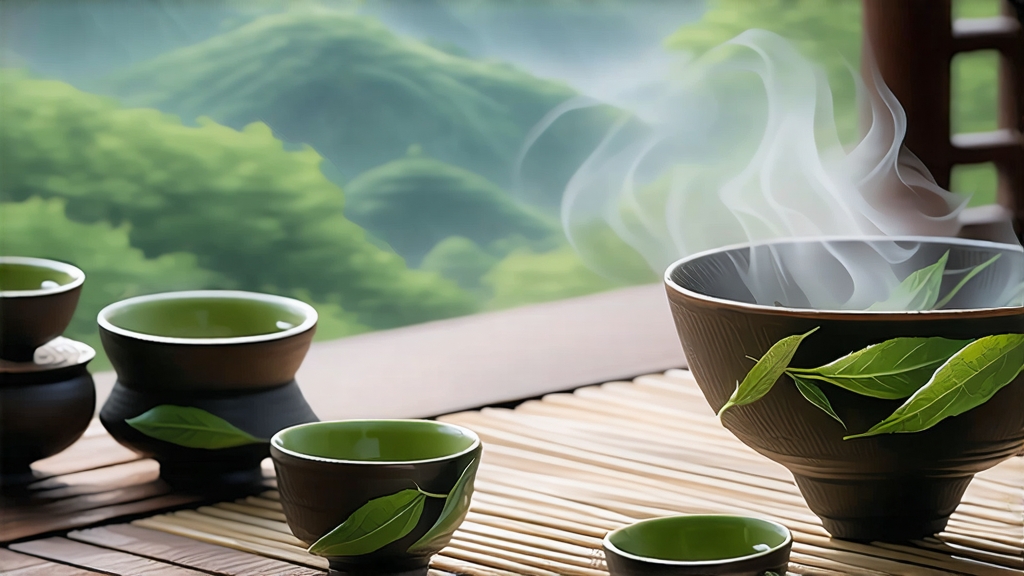
Tie Guan Yin, literally “Iron Goddess of Mercy,” is the most celebrated among China’s oolong teas, a living bridge between green freshness and black depth. Born in Anxi County, southern Fujian, its story begins in the early eighteenth century. A devout farmer named Wei Yin, so the legend goes, discovered a neglected iron statue of Guan Yin, the Bodhisattva of Compassion, hidden in a grotto. After carrying the figure home and burning incense daily, he dreamed one night that the goddess led him to a hidden shrub whose leaves shimmered like wrought iron. Upon waking he found the plant, transplanted it, and from its unusually fragrant tea financed the restoration of the village temple. Whether myth or marketing, the tale captures the reverence Anxi farmers still feel for the cultivar that bears the goddess’s name.
Botanically, Tie Guan Yin is a single, selectively bred variety of Camellia sinensis var. sinensis, distinguished by its thick, serrated, jade-green leaves and a natural tendency toward slow, partial oxidation. Within Anxi it is further subdivided by processing style into three main commercial types. Traditional Tie Guan Yin, “nong xiang,” endures repeated charcoal roasting over low bamboo fires, yielding mahogany leaves that smell of toasted grain and caramel. Modern “qing xiang” or “light aroma” style, dominant since the 1990s, is barely baked, preserving a bright, almost neon-green leaf and an exuberant orchid-lily bouquet. Between these poles lies “zhong huo,” medium-fire, a compromise that keeps floral top notes while adding a whisper of honeyed biscuit. Each style is still 30–50 % oxidized, the hallmark of oolong, yet the divergent finishing techniques create teas that could pass for different species in a blind tasting.
The crafting cycle follows the lunar rhythm of Anxi’s subtropical springs. Picking begins at dawn on the first clear day after Qingming, when two leaves and a bud are still cool with mountain dew. The pluckers, mostly women wearing conical bamboo hats, work in pairs, singing call-and-response couplets that synchronize their speed; a skilled hand can gather three kilograms before the sun clears the ridge. Once back at the village workshop, the leaves are spread on bamboo trays and withered under natural shade, softening cell walls for the critical next step: yao qing, “rocking the green.” In a courtyard perfumed by osmanthus, the tea is tossed inside a cylindrical bamboo drum that rotates every five minutes, bruising edges just enough to liberate enzymes. The process is repeated six to eight times through the afternoon, each cycle monitored by the master who presses a leaf between forefinger and thumb, watching for the tell-tale red fringe that signals oxidation is proceeding evenly.
When the leaf reaches the desired ratio of green center to russet rim, it is wrapped in heavy cotton cloth and loaded into a rolling machine that kneads the leaves into the signature “dragonfly head, toad tail” nugget. This brief compression forces residual juices to the surface, setting up the complex aromatics that will later emerge in the cup. After a short rest, the nuggets are quickly pan-fired at 220 °C to arrest oxidation, then dried in two stages: first with 70 °C hot air to lower moisture to 15 %, then a final 90 °C pass that locks in fragrance while reducing moisture to the export standard of 4 %. For the charcoal-finished versions, an additional month unfolds in subterranean brick rooms where embers of locally harvested longan wood smolder at 50 °C; every forty-eight hours the tea is sifted and re-stacked so that each leaf receives the same gentle kiss of smoke.
To brew Tie Guan Yin well, one must respect its dual personality: half awake like green tea, half dreaming like black. A gaiwan, the lidded bowl of Jingdezhen porcelain, is the instrument of choice because its thin walls conduct heat without hoarding it. Begin by pre-warming every vessel with 95 °C water; this ritual “awakens” the clay or glass and prevents the shock that can flatten aromas. Measure five grams of leaf—about one heaping tablespoon—for a 120 ml gaiwan. The first infusion, known as “washing the goddess,” lasts only five seconds and is discarded; this flash rinse opens the compressed nuggets and rinses away any dust acquired during transport. Immediately follow with